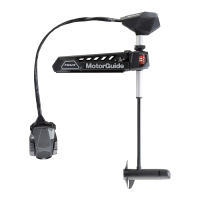GENERAL INFORMATION
Please read and retain this manual. The information contained
in this manual describes the proper procedures for safely
installing, operating and maintaining your motor.
The description and specifications contained herein were in
effect at the time this manual was approved for printing.
MotorGuide, whose policy is one of continual improvement,
reserves the right to discontinue models at any time, to change
specifications, designs, methods of procedures without notice
and without incurring obligation.
Safety and operating information that is practiced along with
good common sense can help prevent personal injury and
product damage.
SAFETY DO’S AND DON’TS
Do not allow children to operate the fishing motor without
adult supervision.
Do not modify the unit in any way or add accessories not
intended for this motor.
The propeller turns when the motor is running.
Always disconnect power from motor when replacing
prop, removing debris around prop, charging
batteries, trailering boat or when the motor is not in
use.
Always make sure motor is securely locked into
stowed position if using a gasoline motor to move
quickly to another location, or when trailering boat.
Be sure to secure loose items on boat before traveling at
high speeds across water.
SPECIFICATIONS
WIRING AND BATTERY RECOMMENDATIONS
Wire and cable routing
• Route trolling motor wires on opposite sides of the boat from
other wiring, directly to trolling motor battery.
• Transducer installation should be installed according to the
manufacturer’s specifications, and cables routed separately
from the trolling motor power cables.
IMPORTANT: Do not route transducer cable down
trolling motor power cord or foot pedal assembly cable.
Route transducer cable down arm of mount, then into
bow console.
• Sensitive electronics, depth finders in particular, should be
connected directly to the main engine battery. If only a one
battery system, then connect with separate cables.
• Motorguide recommends isolating the trolling motor
battery(s) from the main engine battery.
IMPORTANT: Proper rigging guidlines
• Not having a common ground can cause corrosion. If left
unchecked, this problem will damage your motor.
• Establishing a common ground connection will allow
increased sensitivity and improve detail on sonar display.
• Establish a Common Ground – Common ground means
the grounds for the main engine accessories and your
trolling motor are connected to the same terminal.
• Battery Type – The recommended battery(s), 12 volt Deep
Cycle battery with at least 105 ampere hour rating or higher.
• Circuit Protection – MotorGuide recommends installing a
50 amp manual reset circuit breaker in the trolling motor
leads within (1.8 m) 72 inches of the battery(s). To order a
curcuit breaker kit contact your local SuperCenter, order kit
number MM5870.
• Wire Size – For optimum performance, MotorGuide
recommends the use of six (6) gauge wire if extending
existing wire more than (3 m) 10 feet beyond the standard
battery cable supplies with product.
• Bow Plugs – For temporary trolling motor installations,
MotorGuide recommends the use of a quality plug designed
for marine applications.
2
GB
Batteries contain sulfuric acid which can cause severe
burns. Avoid contact with skin, eyes, and clothing. The
battery also produces hydrogen and oxygen gases
when being charges. This explosive gas escapes
through the fill vent cell caps and may form an
explosive atmosphere around the battery for several
hours after it has been charged. Electrical arching or
flames can ignite the gas and cause an explosion which
may shatter the battery and could cause blindness or
other serious injury.
WARNING
Model Volts Kwatts Kilos
30 HT 12 0.20 6.40
46 HT 12 0.28 8.40
54 HT 12 0.34 9.40
54 HTV 12 0.34 11.40
46 FB 12 0.28 14.80
54 FB 12 0.34 16.00
Disconnect trolling motor from battery(s) before
charging
WARNING
90-10235R21 502

